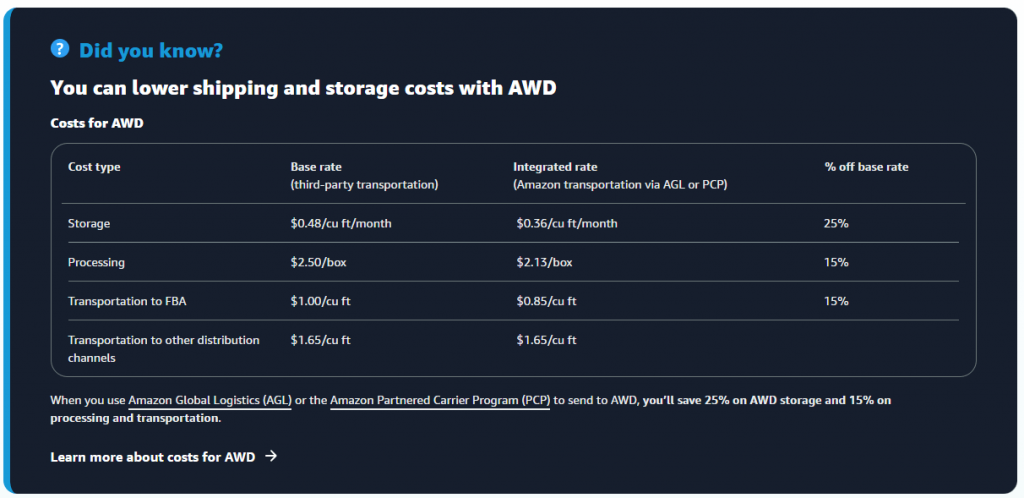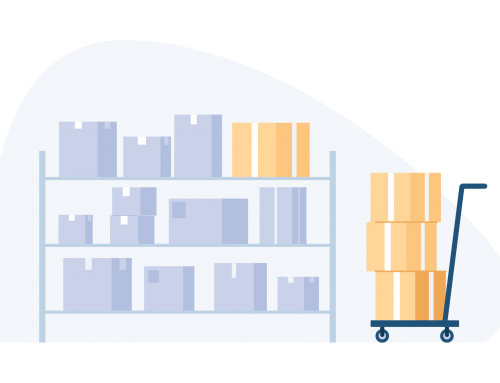What is Amazon Warehousing and Distribution?
Amazon Warehousing and Distribution (AWD) is a low-cost, bulk upstream third-party logistics (3PL) storage solution created to store and distribute your inventory to FBA and other distribution channels. AWD can help you consolidate your inventory, save on shipping and storage costs, as well as streamline restocking FBA with auto-replenishment service. AWD has a pay-as-you-go storage method, so you can store your products indefinitely and with no enrollment fee if you are an FBA seller.
Pros of AWD
Auto-Replenishment: Amazon Warehousing & Distribution manages your inventory replenishment to FBA on your behalf when you have auto-replenishment enabled. Using sophisticated algorithms, AWD calculates how much inventory is optimal in FBA per SKU and sends inventory anytime stock goes below that level. Amazon AWD is quick and reliable when receiving your inventory and restocking FBA. Inventory typically is received by FBA in 10-14 days after the restock request is submitted, and you never have to worry about stockouts in FBA since AWD keeps your listings active and salable if there is inventory available to send to FBA. Auto-replenishment can also boost your IPI by limiting overstock, improving inventory turnover, and exempt you from capacity limits, giving you room to scale your Amazon business, worry-free.
*Tip: Manual replenishment is still available. To learn more about requesting add-on shipments and opting out of auto-replenishment, click here.
Low-Cost Storage: Using Amazon Warehousing and Distribution can cut down on shipping and storage costs as well as FBA fees. Utilizing Amazon’s vast fulfillment and supply chain network can often lower your 3PL costs, including additional discounts granted when using Amazon Global Logistics (AGL) and Amazon Partnered Carrier Program (PCP) in tandem. AWD storage fees are pay-as-you-go and do not increase during peak holiday seasons, unlike FBA, so you will save during the most important period and avoid hidden fees.
AWD also reduces FBA fees by exempting your products from certain fulfillment fees. Amazon Warehousing and Distribution pricing covers the FBA inbound placement services, automatically eliminating the inbound placement fee and if your auto-replenishment ratio is greater than 70%, you will not be subject to overage fees or low-inventory-level fees.
Inventory Consolidation: Amazon AWD is not just for warehousing FBA products, but also for multi-channel distribution (MCD). With MCD, sellers can consolidate into a single pool of inventory which can be shipped in bulk to other sales channels, to your own warehouse, 3PLs, wholesalers and distributors. This allows sellers to take advantage of discounted shipping rates through Amazon Global Logistics (AGL) and be at ease relying on a trusted warehousing and distribution partner. AWD typically replenishes inventory to multi-channel destinations within 14 days on average and provides tracking right from the AWD dashboard.
For more information on enrolling in multi-channel distribution using AWD, click here.
Cons of AWD
AWD can be a blessing for many sellers, but there are a few drawbacks and restrictions. AWD only accepts less than truckload (LTL) and Full truck load (FTL) shipments; small parcel shipments are currently not accepted. This can cause some delays as LTL/FTL shipments take longer to process. In addition, AWD does not accept mixed SKU cartons, each SKU will need to be individually boxed and no more than 150 SKUs can be added to a single shipment. AWD also follows the same product regulations as FBA, but with a few additional ineligible product types currently.
Amazon Warehousing and Distribution ineligible product types:
- Perishables: grocery or any product that requires expiration dates
- Oversize, heavy, or bulky products
- Dangerous goods and hazardous materials prohibited by FBA
- Jewelry, shoes, & watches
- High-value products
Visit Amazon Warehouse and Distribution (AWD) Product Eligibility for a full product list and guidelines.
Consider AWD if the following affect your business:
- FBA storage capacity limits
- Frequent stockouts or overstocking FBA
- Complicated supply chain
- High 3PL fees and FBA shipping/storage fees
Using ForecastRx Alongside AWD to Optimize Inventory Management
Even when using auto-replenishment through AWD, you should still implement forecasting and inventory management software. Instead of using the RestockAMZ portion of ForecastRx to create FBA shipments, you would use ForecastRx purchasing recommendations to create your purchase orders that will be sent to AWD for storage and forecast your sales to know exactly when to reorder product. Amazon Warehousing and Distribution saves time and money on the FBA side, but you will still need to purchase the right quantity and ship it to AWD in time, so your products do not go out of stock.
Additionally, AWD auto-replenishment “relies on a proprietary data-science model that monitors the inventory levels in Prime-ready fulfillment centers” meaning there is an algorithm behind their replenishment that calculates the optimal stock level per product, but it might not identify seasonal trend that an established seller would anticipate. It also would not be able to identify upcoming promotions that would require a higher inventory quantity in FBA. To get ahead of this, you can request add-on shipments from AWD to FBA. The RestockAMZ portion of ForecastRx can provide you recommendations for your add-on shipments. ForecastRx analyzes your sales trends and seasonality to provide accurate restock quantities based on anticipated upcoming demand. Additionally, ForecastRx gives sellers the ability to modify forecasts for instances such as sales promotions, so your restock quantities will take the increasing demand into account.
For more information on getting started with AWD, visit Amazon Warehousing and Distribution, and sign up for your free trial with ForecastRx to create perfect purchase orders.





